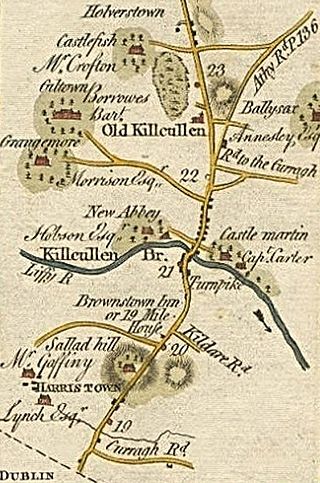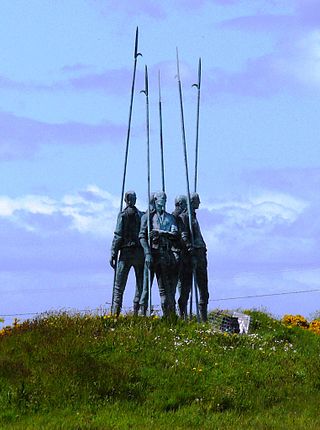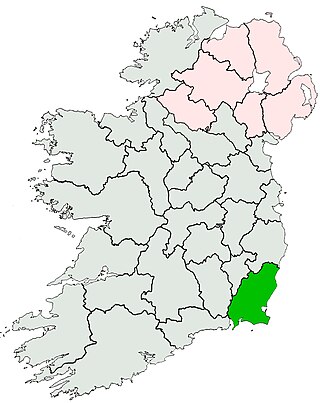
Arklow is a town in County Wicklow on the southeast coast of Ireland. The town is overlooked by Ballymoyle Hill. It was founded by the Vikings in the ninth century. Arklow was the site of one of the bloodiest battles of the 1798 rebellion. Its proximity to Dublin led to it becoming a commuter town with a population of 13,163 as of the 2016 census. The 2022 census recorded a population of 13,399.

The Irish Rebellion of 1798 was a popular insurrection against the British Crown in what was then the separate, but subordinate, Kingdom of Ireland. The main organising force was the Society of United Irishmen. First formed in Belfast by Presbyterians opposed to the landed Anglican establishment, the Society, despairing of reform, sought to secure a republic through a revolutionary union with the country's Catholic majority. The grievances of a rack-rented tenantry drove recruitment.

The Battle of Cowpens was an engagement during the American Revolutionary War fought on January 17, 1781 near the town of Cowpens, South Carolina, between American Patriot forces under Brigadier General Daniel Morgan and British forces, nearly half American Loyalists, under Lieutenant Colonel Banastre Tarleton, as part of the campaign in the Carolinas. The battle was a turning point in the American reconquest of South Carolina from the British.

The Battle of Kilcullen took place on 24 May 1798 near the two settlements of that name in County Kildare, and was one of the first engagements in the Irish Rebellion of 1798 consisting of two separate clashes between a force of United Irish rebels and government forces.

The Battle of Vinegar Hill was a military engagement during the Irish Rebellion of 1798 on 21 June 1798 between a force of approximately 13,000 government troops under the command of Gerard Lake and 16,000 United Irishmen rebels led by Anthony Perry. The battle, a major rebel defeat, took place on 21 June 1798 on a large rebel camp on Vinegar Hill and in the streets of Enniscorthy, County Wexford and marked the last major attempt by the rebels to hold and control territory taken in Wexford.

The Battle of Three Rocks was a United Irish victory during the Wexford Rebellion, a part of the 1798 rebellion, against a British artillery column marching to reinforce Wexford town against anticipated rebel attack.
The Battle of Ballyellis on 30 June 1798 was a clash during the Irish Rebellion of 1798, between a surviving column of the dispersed Wexford rebel army and pursuing British forces which resulted in a victory for the rebels.

The second Battle of Arklow took place during the Irish Rebellion of 1798 on 9 June when a force of United Irishmen from Wexford, estimated at 10,000 strong, launched an assault into County Wicklow, on the British-held town of Arklow, in an attempt to spread the rebellion into Wicklow and to threaten the capital of Dublin.

The Battle of Castlebar was a military engagement of the Irish Rebellion of 1798 which occurred on 27 August 1798 near the town of Castlebar, County Mayo. A combined force of 2,000 French Revolutionary Army troops and United Irishmen rebels routed a British Crown force of 6,000 men mainly consisting of Irish militiamen by Gerard Lake, 1st Viscount Lake in what would later become known as the "Castlebar Races" or "Races of Castlebar".

The 9th Queen's Royal Lancers was a cavalry regiment of the British Army, first raised in 1715. It saw service for three centuries, including the First and Second World Wars. The regiment survived the immediate post-war reduction in forces, but was amalgamated with the 12th Royal Lancers to form the 9th/12th Royal Lancers in 1960.
Anthony Perry, known as the "screeching general" was one of the most important leaders of the United Irish Wexford rebels during the 1798 rebellion.
The battle of Ovidstown was a military engagement between British Crown forces and United Irishmen rebels during the Irish Rebellion of 1798 near the town of Kilcock, County Kildare. Despite the initial failures experienced by the United Irishmen in County Kildare during the first months of the rebellion, the consolidation of government forces in the town of Naas and the priority given by the Dublin Castle administration to suppress the Wexford Rebellion in County Wexford meant that much of the county remained in rebel hands since the outbreak of the rebellion. Towns such as Prosperous and Clane were in rebel hands, while towns such as Maynooth, Kilcock and Kildare had been attacked and briefly occupied by the rebels. By 19 June, however, neighbouring County Meath had been judged sufficiently pacified to allow for government forces to be dispatched from that county into Kildare to recapture rebel-held territory.

The 4th Royal Irish Dragoon Guards was a cavalry regiment in the British Army, first raised in 1685 as the Earl of Arran's Regiment of Cuirassiers. It was renamed as the 4th Dragoon Guards in 1788 and service for two centuries, including the First World War, before being amalgamated with 7th Dragoon Guards, to form the 4th/7th Dragoon Guards in 1922.

John Murphy was an Irish Roman Catholic priest of the Roman Catholic Diocese of Ferns, who is mainly remembered for his central role in the Irish Rebellion of 1798 in County Wexford, which is sometimes known as the Wexford Rebellion. He led the rebels to one of their initial victories over a government militia at Oulart Hill, and in the following weeks became one of the rebellion's main leaders.
Events from the year 1798 in Ireland.
The Battle of the Harrow took place on 26 May 1798 and was the first clash of the Irish Rebellion of 1798 in County Wexford. It was fought between government forces and United Irishmen insurgents under the leadership of a local priest, John Murphy who had mobilized following reports of atrocities by the yeomanry during the rebellion led by the United Irishmen revolutionary organisation.

The Wexford Rebellion refers to the events of the Irish Rebellion of 1798 in County Wexford. From 27 May until 21 June 1798, Society of United Irishmen rebels revolted against British rule in the county, engaging in multiple confrontations with Crown forces. The most successful and destructive rising in all the counties of Ireland, United Irishmen rebels experienced a number of early successes in the county despite being seen as a relatively loyal county by the Dublin Castle administration due to a series of military victories. However, the tide soon turned against the United Irishmen in Wexford as Crown forces poured into the region, engaging in a brutal counterinsurgency which indiscriminately targeted suspected rebels and eventually suppressed all rebel activities in the county.

County Wexford is a county located in the south-east of Ireland, in the province of Leinster. It takes its name from the principal town, Wexford, named 'Waesfjord' by the Vikings – meaning 'inlet (fjord) of the mud-flats' in the Old Norse language. In pre-Norman times it was part of the Kingdom of Uí Cheinnselaig, with its capital at Ferns.
The Battle of Arklow was a minor skirmish that took place at Glascarrig on the coast road near Arklow in County Wicklow on 1 November 1649. It was fought between the army of the Parliamentarians and the combined forces of the Irish Royalists and Confederates during the Irish Confederate Wars.
The battle of Marshall's Elm was a skirmish that took place near Street, in the county of Somerset, South West England, on 4 August 1642. The engagement occurred during the build-up to formal beginning of the First English Civil War on 22 August, while the Royalists and Parliamentarians were recruiting men in the county. The Royalists had established their regional headquarters in Wells, but were threatened by superior Parliamentarian numbers in the vicinity. The Royalist commander sent out a mounted patrol consisting of 60 to 80 cavalry and dragoons, which came across a force of between 500 and 600 Parliamentarian recruits travelling north across the Somerset Levels under the command of Sir John Pyne.












